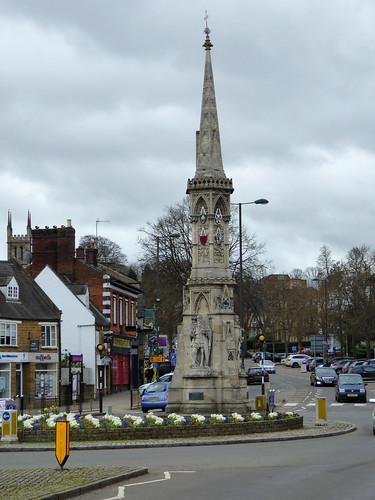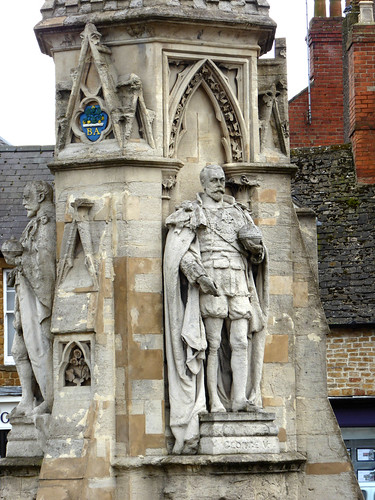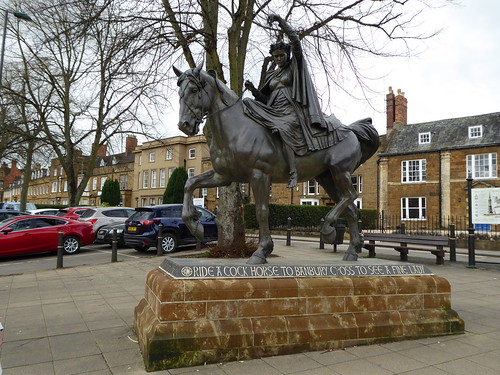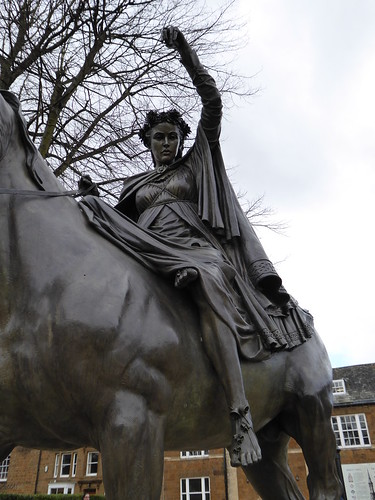Banbury Cross
In the middle ages three crosses stood in different locations around the town. All three, The White Cross in West Bar, The Bread Cross near Butchers Row and High Street and finally The High or Market Cross in Cornhill were destroyed by puritans at the star of the 1600’s. The puritans disliked religious imagery and the superstitions associated with it.
There are no remains of these crosses visible today but plaques mark their likely locations.
The current cross which was erected in 1859 to celebrate the marriage of Princess Victoria, eldest daughter of Queen Victoria to Prince Frederic of Prussia, reaches a height of 16 metres.
The carvings on the lower section of the cross display the arms of the Town at different times and include the Town’s motto ‘Dominus sol et scutum’ – which translates into ‘God our sun and shield.
The statues of Queen Victoria, Edward VII and George V were added in 1914 to mark the coronation of George V.
On the upper sections are the coats of arms of people who have a strong connection with the town.*
The Fine Lady Upon a White Horse Statue
This statue was funded and erected by the people of Banbury to commemorate the nursery rhyme which has made Banbury famous throughout the English speaking world.
Ride a cock horse to Banbury Cross,
To see a fine lady upon a white horse;
With rings on her fingers and bells on her toes,
She shall have music wherever she goes.The rhyme contains three essential elements Banbury Cross, the ‘cock horse’ and a Fine Lady Upon a White Horse.
One explanation of the ‘Cock Horse’ is the children’s hobby horse and Banbury holds a Hobby Horse Festival in the first weekend of July each year, with a parade of hobby horse ‘beasts’ through the town and Hobby Horse Races held in People’s Park.
The statue of the Fine Lady upon the White Horse now brings the rhyme to life all year round.
The statue was designed by Artcycle Ltd, cast in bronze and mounted on a plinth of local Hornton Stone.
The horse, which was sculpted by Denise Dutton is modeled on a Welsh Cob. The Fine Lady is depicted as the ‘Queen of May’ and incorporates many symbols of spring.
She wears a crown of thirteen spring flowers, alternating daffodils and wild roses, symbolising the thirteen ancient calendar months. A butterfly has landed among the flowers and a moth has settled on her hood.
The bells on her feet are interpreted as both musical bells and by seven bluebells representing the days of the week. She drops petals from her raised left hand to bring us prosperity. The rings represent power.
The frog represents metamorphosis, the cycle of nature and community.
The other symbol to look for is the Sun, which has been the symbol of Banbury since the sixteenth century.*
*From a sign board next to the statue












This reminded me of the Malmesbury Cross in Wiltshire, except that one has a useful daily function (to shelter market traders from the weather) and one has perhaps a religious, ceremonial function. Love it!
I remember sitting and dining looking out at Malmesbury Cross. It is so difficult to get a good photograph of it due to cars being in the way.
Lovely photos – so interesting to read about the Fine Lady on a White Horse especially all the information about symbols of Spring – a wonderful post
I found the information about the statue quite fascinating. And yes we did look to see if we could see all the finer details mentioned on the sign board
i liked the sculpture, with all of its realism, CP.
It is an impressive sculpture
The White Horse is ubiquitous in the English speaking world.
The nursery rhyme is something we learned as kids. Then there are those mysterious ones carved onto the Wiltshire hills.